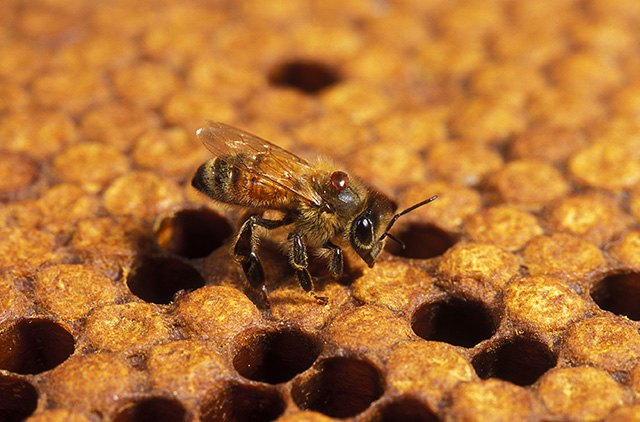Social immunity of bees
by Liza Lester, ESA communications officer
A honey bee (Apis mellifera) afflicted with Varroa destructor, a parasitic mite that sucks away its vital, blood-like hemolymph, often passing along viruses in the process, and leaving open wounds. The mite spreads by bee-to-bee contact, accelerated by yearly circuits of agricultural bee broods transported to pollinate almonds and blueberries and other crops. Varroa is a suspect in the still mysterious and ongoing bee disappearance known as colony collapse disorder. But mitocides are suspect as well. Credit, Stephen Ausmus, USDA.
FOOD maven Lynne Rossetto Kasper, host of the American Public Media radio show The Splendid Table, talked honey bees with entomologist Marla Spivek in a long segment for her May 12th show.
Spivak takes her host outside the studio and into the apiary to look inside the secrets of the hive. Over a hum of wings, they talk about the daily activities of male drones, female worker bees, nurse bees, larvae, and the queen – laying her thousand eggs a day.
Spivak is a 2010 MacArthur Fellow and Distinguished McKnight Professor in Entomology at the University of Minnesota, where she runs her Bee Lab.
In 2006, an abrupt bee population crash began and spread around the world. Bee populations have been diminishing since WWII, Spivak says, in concert with the vast agricultural changes of the last century, but why the current crisis set in with such suddenness is a mystery. An alarming, expensive mystery. Bees pollinate a third of our fruits and vegetables.
We have developed an ag system that depends for fertility on the specific ministrations of Apis mellifera – an old world bee that migrated to the Americas (and Australia and New Zealand) with Europeans and European agriculture. Farmers contract with apiarists to bring hives to their orchards and fields seasonally. Some hives have extended tours.
All this migratory labor can be hard on bees. Spivak says colony collapse disorder is most likely the result of a potpourri of deadly influences: the stresses of travel, viral infections, parasite infestations, and pesticides. Researchers are looking for a new disease or new pesticide that might be the kicker on the evil brew. In happier news, public consciousness of bees has jumped since the collapse, with a surge in interest in beekeeping and bee-friendly landscaping.
Spivak’s lab investigates bees’ natural defenses, bee pathogens, and landscape effects on bees and other pollinators, and is working on breeding resistance into their bees. Spivak says bees cope with infection in the hive by “sniffing out larvae when they’re sick” and tossing the sick out of the colony.
Bee biologists have recently begun thinking of this “social immunity” as analogous to vertebrate adaptive immunity – the arsenal of patrolling T-cells and macrophages, and antibody-producing B-cells, etc. that repel threats to our own bodies. In the body of the hive, individual bees act the part of the killer T-cells, disposing of dangerously infected siblings. Such hygienic behavior is genetic, an inherited trait that Spivak can select for in her breeding experiments, to help build a sturdier bee.
Listen to the Splendid Table podcast.
More about honey bees:
- Tammy Horn. “Honey Bees: a History.” NY Times April 11, 2008, 1:05 pm
- Alternative Pollinators from David Gordon, biologist at Pittsburg State University
- Eric Mader, Marla Spivak, Elaine Evans. Managing Alternative Pollinators: A Handbook for Beekeepers, Growers, and Conservationists. NRAES-186, Plant and Life Sciences Publishing, 2010. (free to download)
- Allison Benjamin. “New York beekeepers quadruple.” The Guardian, Friday 16 March 2012 08.36 EDT
- Marc Lifsher. “Hives for Hire.” Los Angeles Times, March 03, 2012
- Francis L. W. Ratnieks and Norman L. Carreck. “Clarity on Honey Bee Collapse?” Vol. 327 no. 5962 pp. 152-153. Science 8 January 2010. DOI: 10.1126/science.1185563
- Caspar Schöning et al. Evidence for damage-dependent hygienic behaviour towards Varroa destructor-parasitised brood in the western honey bee, Apis mellifera. J Exp Biol 215, 264-271. January 15, 2012. doi: 10.1242/jeb.062562
- Sylvia Cremer and Michael Sixt. Analogies in the evolution of individual and social immunity. doi: 10.1098/rstb.2008.0166 Phil. Trans. R. Soc. B 12 January 2009 vol. 364 no. 1513 129-142
